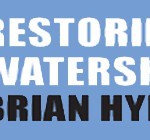Restoring Our Watersheds
Don’t Ever Call It ‘Platte To Park Hill’ Again
A Challenge To Our Elected Leaders
By Brian Hyde
Greater Parkhill Community Inc.
I trusted – far too much – that our elected leaders, as well as appointed leaders, would finally do the right thing with regard to the stormwater fee increase and its linkage to the financing of what I call the “Golf Course to I-70” project.
I expected that, at the very least, the direct linkage of the fee increase to the financing of that ill-conceived bundle of ideas would be severed.
I apologize to readers for previously not speaking out more forcefully. I apologize for spending too long trusting that the technical and ethical deficiencies of a process whereby we the taxpayers – whether upstream of I-70 or not – are financing someone else’s development projects in the bottomlands, miles away from Park Hill.
Instead of listing the problems with this entire process over the debacle of the City Council’s June 13 approval of a stormwater rate hike to pay for the “Golf Course to I-70” project, let me issue a challenge to the elected leaders of Denver, to their staff, and to their consultants. I challenge them to take some explicit steps to better serve the Montclair Creek and Park Hill Creek watersheds and their residents.
First, show us you understand the problems.
Get rid of the inappropriate name, “Platte to Park Hill” and do not ever, ever, ever use that name in our neighborhoods again. Call it, as I will, the “Golf Course to I-70” project. This project will capture all of the Montclair Creek flows in a ditch at 39th Avenue northwest of Park Hill. It will then connect that ditch to pipes under the railroad, and force those flows through an artificial channel into an artificial “confluence” at Globeville Landing Park, approximately one mile upstream of its historic and natural confluence with the South Platte River.
The project starts at the City Park Golf Course, well downstream of the lowest point in Park Hill at Batavia Place and Colorado Boulevard, and extends downstream. No part of the project is in Park Hill and it provides no flood protection to Park Hill.
Second, do not try to tell us again that the City Park Golf Course detention facility and the big east-west ditch along 39th Avenue have nothing to do with I-70 or the redevelopment along I-70. Either admit that, or say nothing at all about it.
Third, show respect for our watersheds. Treat them as you would your children or other loved ones.
Fourth, within three months, develop straightforward documents that show us how much of our annual stormwater fees for 2016–2026 will go to each of the floodplain management and stormwater projects in the city. Include in those documents maps to show what geographic areas are being helped through the expenditure of the increased stormwater fees.
Welcome citizen involvement
The following are a few steps to making protecting our watersheds a priority, welcoming citizen involvement and tying the spending of our stormwater fees directly to master plans:
1. Create a citywide citizens watershed floodplain and stormwater advisory board. This board should be comprised of citizens from watersheds throughout Denver who will serve one-year terms to maximize transparency and the representation of a cross-section of our city. The board will review the process of spending our stormwater fees every year, and will evaluate the specific benefits to our watersheds from the projects that are funded.
2. Create watershed enhancement coalitions for each watershed in Denver. The Registered Neighborhood Organizations within whose territory the particular watershed is located will select the members of the coalitions.
3. Initiate, with the Urban Drainage & Flood Control District and with technical assistance from the Colorado Association of Stormwater and Floodplain Managers, the development of a standardized format for watershed restoration and rehabilitation master plans.
4. Tie the spending of stormwater fees to those master plans.
Defensible and transparent
Our city leaders should require watershed master planning that is scientifically defensible and transparent.
Moving forward, here are some steps that can be taken: All watershed restoration and rehabilitation master plans for the Montclair Creek and Park Hill Creek watersheds should include the completion of an inventory of existing conditions and an identification of floodplain and stormwater restoration and rehabilitation needs.
No alternatives to address flooding and or stormwater problems in the Montclair Creek and Park Hill Creek watersheds should be developed or considered until the inventory and identification of needs of the master plans have been reviewed and approved by the coalition for that watershed, and reviewed and certified by the watershed board.
City leaders must develop a standardized process for public engagement and formally adopt it. In conjunction with the watershed coalitions, the watershed board will develop, within one year of the initial increase in stormwater fees, a process for public engagement in all future planning and design studies in any of the city’s watersheds.
The recommended process will be submitted to city council’s Infrastructure and Cultural Affairs Committee for review and discussion. Ultimately the finalized recommendations for public engagement will be submitted to the full city council for approval and adoption.
Finally, city leaders should tie the spending of our stormwater fees to those master plans and to the process for public engagement that is adopted by the city council.
A real show of understanding and courage by city leaders would be to apply the above procedures and standards to the project they approved last month – the “City Park to I-70” project.
Brian Hyde is an expert in floodplain management and stream restoration. He wants your feedback at westerly_connect_brian@comcast.net or 720-939-6039
![]()



Comments
Restoring Our Watersheds — No Comments
HTML tags allowed in your comment: <a href="" title=""> <abbr title=""> <acronym title=""> <b> <blockquote cite=""> <cite> <code> <del datetime=""> <em> <i> <q cite=""> <s> <strike> <strong>